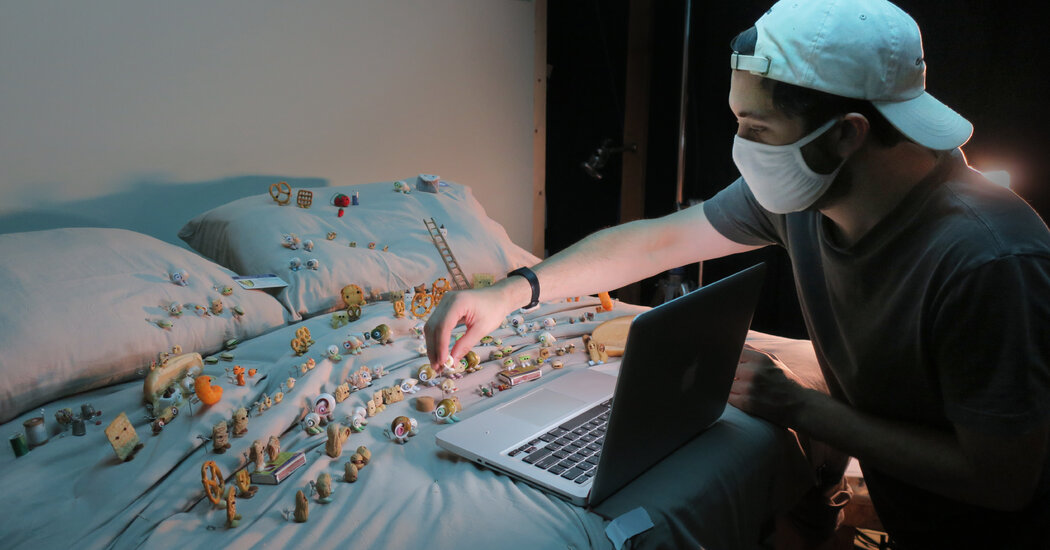
When the director Dean Fleischer Camp and his co-writer and star Jenny Slate made their first short of “Marcel the Shell with Shoes On” in 2010, they couldn’t have imagined its impact: more than 32 million views to date on YouTube, with an additional 11.3 million and 4.6 million for its two follow-ups. Those shorts have now been adapted into a feature film, an idea that was both tantalizing and scary, posing numerous challenges of technical know-how and sheer scale.
“It was night and day, production-wise, because the shorts were just me alone in my bedroom,” Camp said in a Zoom interview. The feature film was something quite different: a crew of approximately 500 filmmakers and technicians, working together for well over a year. The director worried that expanding the scope and size of the production could rob the project of its original, low-fi, low-budget charm. “I think especially with processes that are really technical,” he said, “you can very easily lose the authentic, organic thing.”
The technical process in question is stop-motion animation. Marcel the Shell with Shoes On is just that — a one-inch hermit crab shell with a pair of tiny shoes. His movements are created via one of the oldest filmmaking processes available, in which a series of still photographs, with the tiniest of movements between them, create the impression of an animated object.
“Those original shorts, I just kept the camera static as much as possible,” Camp confessed. He could do that for those short spurts (they each run three to four minutes). But a feature-length narrative would require more movement, more locations and more interactions with other characters.
“The big technical hurdle is, how do we actually pull off the integration between the live-action world and the stop-motion world,” the film’s animation director, Kirsten Lepore, explained over Zoom. “So we had a lot to figure out, and we explored a lot of different ideas.”
This meant doing a bit of cross-pollination, according to Camp. “The specialists don’t really intersect ever,” he said. “And so it was about getting these pieces of information from different groups, and then getting those two different departments to hold hands.”
It made for an unorthodox production, to put it mildly. The scripting process was unusual itself; because “Marcel the Shell with Shoes On” is structured as a quasi-documentary, Camp and the co-screenwriter Nick Paley wrote the script in spurts, meeting for a few days at a time to write dialogue scenes before recording them with the other co-screenwriter Slate, who voices Marcel, and the film’s other voice actors.
They kept those sessions loose, to capture variations and improvisations, which they would edit into audio scenes before moving on to another chunk of the story. “So by the end of that,” Camp said, “the audio is essentially locked. We basically arrived at a finished audio play and a screenplay at the same time.”
But creating the visual accompaniment, mixing “real” live action with stop-motion animation, amounted to “two shoots, essentially,” according to Lepore. “It was like a full live-action shoot, and then a year later, a full stop-motion shoot. So basically shooting the movie twice.”
First, they would shoot what is called a live-action “plate,” with the action of each shot minus Marcel and any other stop-motion elements or characters — but carefully approximating the focus to where Marcel would eventually be (Lepore was on set, with a small Marcel puppet on a stick).
Later, on a stop motion stage, they would project that clean plate behind the stop-motion objects, taking pains to recreate the exact lighting of the original shoot, so all the elements would match. “Our stop motion director of photography took meticulous notes of every single shot,” Lepore said. “He did overhead diagrams, he was out with measuring tape, like how far is this light from the character and from the set and everything.”
This was the labor-intensive process for shots where the camera was locked down on a tripod. When adding in camera movements, the process became even more complex — camera movements were tracked digitally when creating the live-action plate, according to Lepore, “and then that camera movement gets translated into motion-control cameras that can handle that data on the stop-motion stage, and then a motion-control camera is, frame by frame, moving through this exact same move.”
The format of the film, as with the original shorts, is semidocumentary; Camp appears on-screen, and as an off-camera voice, interviewing Marcel and capturing off-the-cuff images of the shell’s daily life. So that was one more complication for the filmmakers: creating a sense of documentary spontaneity within the meticulous animation project, as well as replicating visual cues of the form, particularly hand-held camerawork.
After a failed attempt to create a hand-held look digitally, they used tracking and motion control for those scenes as well. “You feel that really subtle rotational stuff that just happens with the natural camera movement,” Lepore said. “And then we just had a ton of tracking markers and dots.”
It amounted to a “truly, truly crazy way to make a movie,” Camp said. “I’ve always thought it’s sort of like a David Blaine trick where you’re like, oh, there’s no trick here. The trick is that you poured, like, thousands of hours into it.” Lepore said she concurred with this philosophy of “just crazy, meticulous planning.”
“Everything was done on a shot-by-shot basis and under a microscope — to hopefully make it feel like it was effortless.”



